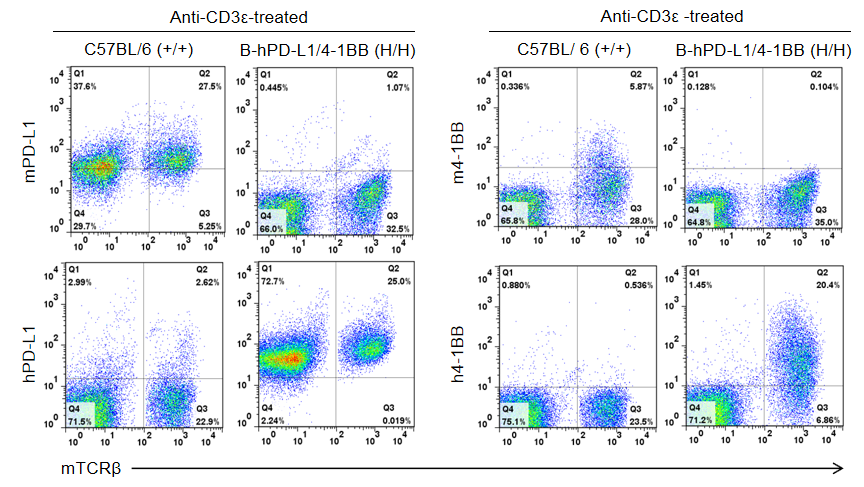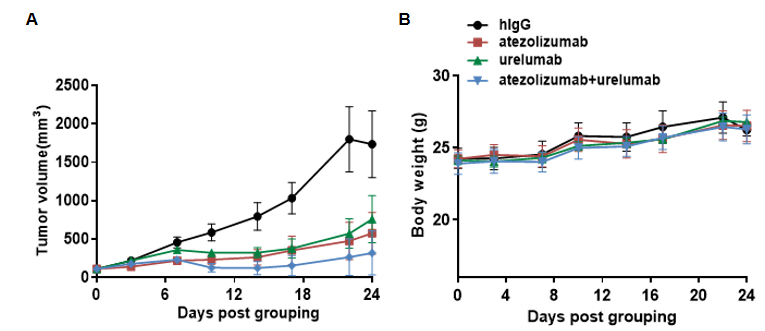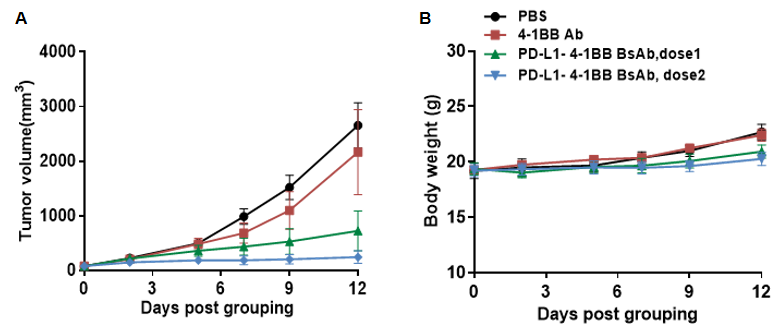B-hPD-L1/h4-1BB mice
| Strain Name |
C57BL/6-Cd274tm1(CD274)Bcgen Tnfrsf9tm1(TNFRSF9)Bcgen/Bcgen
|
Common Name | B-hPD-L1/h4-1BB mice |
| Background | C57BL/6 | Catalog number |
120535 |
|
Related Genes |
Cd274 (CD274 antigen) TNFRSF9(tumor necrosis factor receptor superfamily, member 9) |
||
|
NCBI Gene ID |
60533,21942 | ||
Protein expression analysis

Strain specific PD-L1 and 4-1BB expression analysis in homozygous B-hPD-L1/h4-1BB mice by flow cytometry. Splenocytes were collected from wild type C57BL/6 mice (+/+) and homozygous B-hPD-L1/h4-1BB mice (H/H) stimulated with anti-CD3ε in vivo, and analyzed by flow cytometry with species-specific anti-PD-L1 and anti-4-1BB antibodies. Mouse PD-L1 and 4-1BB was detectable in C57BL/6 mice but not in homozygous B-hPD-L1/h4-1BB mice. Human PD-L1 and 4-1BB was exclusively detectable in homozygous B-hPD-L1/h4-1BB mice but not in C57BL/6 mice.

Antitumor activity of combination of anti-human PD-L1 antibody (atezolizumab,in house)and anti-human 4-1BB (urelumab, in house) in B-hPD-L1/h4-1BB mice. (A) combination of anti-human PD-L1 antibody and anti-human 4-1BB antibody inhibited MC38 tumor growth in B-hPD-L1/h4-1BB mice. Murine colon cancer MC38 cells were subcutaneously implanted into homozygous B-hPD-L1/h4-1BB mice (male, 6-week-old, n=6). Mice were grouped when tumor volume reached approximately 100 mm3, at which time they were treated with anti-human PD-L1 antibody and anti-human 4-1BB antibody with doses and schedules indicated in panel. (B) Body weight changes during treatment. As shown in panel A, combination of anti-human PD-L1 antibody and anti-human 4-1BB antibody were efficacious in controlling tumor growth in B-hPD-L1/h4-1BB mice, demonstrating that the B-hPD-L1/h4-1BB mice provide a powerful preclinical model for in vivo evaluation of combination of anti-human PD-L1 antibody and anti-human 4-1BB antibody. Values are expressed as mean ± SEM.

Antitumor activity of anti-4-1BB antibody and anti-4-1BB-PD-L1 bispecific antibody in B-hPD-L1/h4-1BB mice. (A) Anti-4-1BB antibody and anti-4-1BB-PD-L1 bispecific antibody inhibited B16F10-hPD-L1 tumor growth in B-hPD-L1/h4-1BB mice. B16F10-hPD-L1 cells were subcutaneously implanted into homozygous B-hPD-L1/h4-1BB mice (female, 7-week-old, n=6). Mice were grouped when tumor volume reached approximately 100 mm3, at which time they were treated with anti-4-1BB antibody and bispecific antibody with doses and schedules indicated in panel. (B) Body weight changes during treatment. As shown in panel A, the bispecific antibody were more efficacious in controlling tumor growth in B-hPD-L1/h4-1BB mice compared with PBS and the anti-4-1BB antibody group, demonstrating that the B-hPD-L1/h4-1BB mice provide a powerful preclinical model for in vivo evaluation of anti-human PD-L1 antibody, anti-human 4-1BB antibody or related bispecific antibody. Values are expressed as mean ± SEM.








